Your cart is currently empty!
How to Measure Dimensions for a New Bathroom
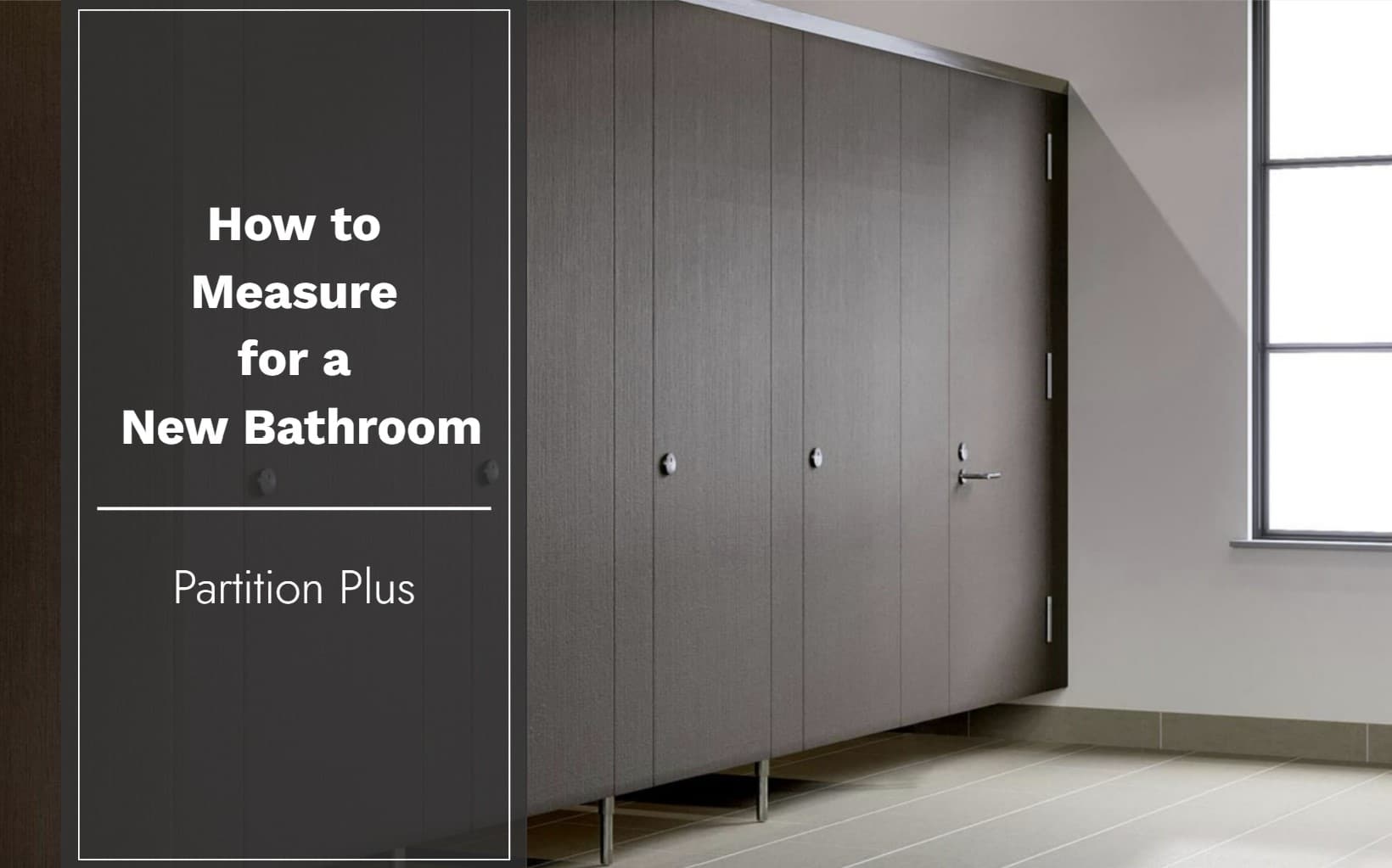
Building a bathroom takes a lot of planning. You will need toilets, stalls, sinks, and so much more. But how many toilets, what types of stalls, and how much is all of it going to cost? All of these are essential questions and worth some pre-planning. That is why we made this guide on finding the measurements you need to get started.
Step 1: Measure Public Bathroom Dimensions
The first thing you need to know is the dimensions of your public bathroom. Measure the length of each restroom wall, being sure to account for any alcoves or protrusions. It is helpful to draw a diagram of your bathroomroom and label it with the measurements. Your drawing can ensure you do not forget or confuse numbers.
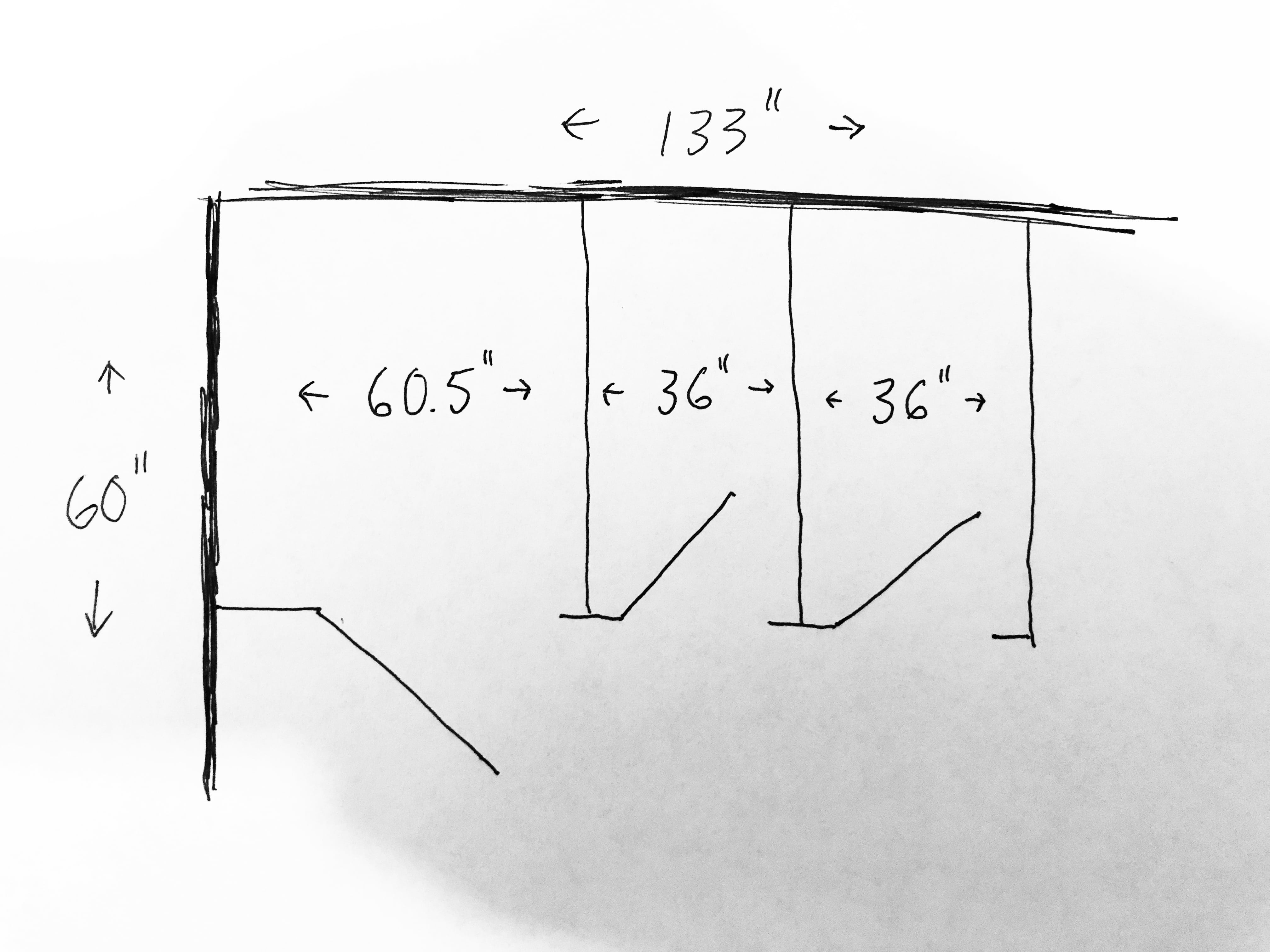
You do not have to be an artist to get a drawing that will help you when you begin to decide where you want your stalls, sinks, toilets, and accessories in your bathroom. Knowing your measurements will allow you to select items that are the correct width and communicate better with your team.
Step 2: Choose the Number of Toilets You Need
Before you decide on the type and size of fixtures you want, you need to know how many you should have. This number highly depends on the number of people and employees you have and the square footage of your establishment.
Toilets per Employee
The minimum number of toilets you need based on your number of employees is a simple number to find. The following chart is from the Occupational Safety and Health Administration (OSHA). It determines how many toilets you will need in your bathroom per the number of employees of a given sex. For example, if you have 20 employees total, you must have a minimum of two toilets in your establishment.
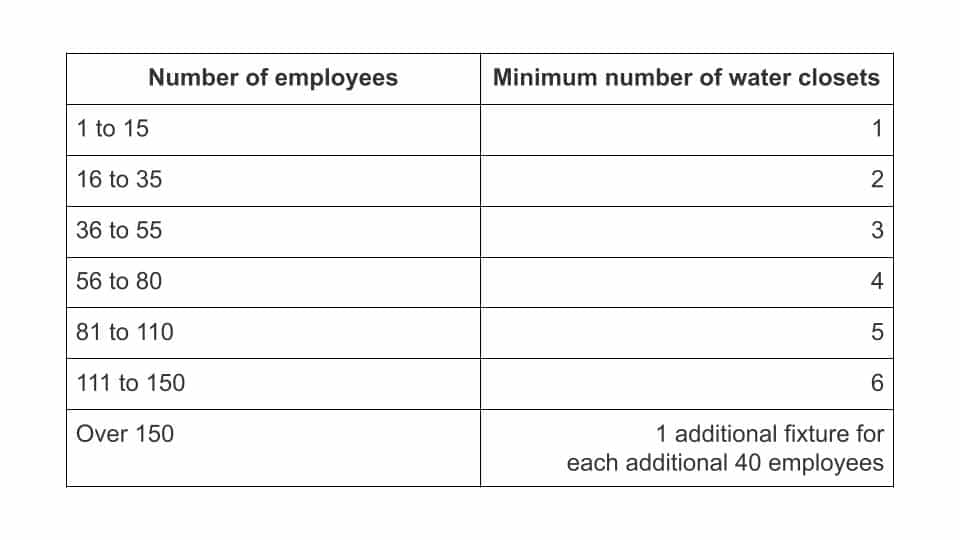
These toilets should be divided into different gendered restrooms unless you have less than 15 employees. If you have less than 15 employees, you may have a unisex toilet. However, only one person should occupy the room at one time and the restroom should be lockable from the inside.
Toilets and Other Fixtures per Occupancy and Square Footage
Second, you should figure out your occupancy and the number of toilets you need. You can do this by consulting the rules of the International Building Code (IBC) and the International Plumbing Code (IPC). First, determine which type of building you have based on your establishment’s category, whether the sitting present is fixed or movable, and other factors. After that, take the square footage of your building and, using the method provided for your building type, determine your occupancy. From there, you can split the occupancy in half to find the number of women and men for whom you should prepare bathrooms. The IBC lists this number as one bathroom for every “x” number of women/men. These rules also include information on how many lavatories and fountains you will need per person. The IPC also goes over how many toilets you can switch out for urinals in a restroom.
Determining your occupancy or even the type of establishment you have can be complicated. We recommend consulting a contractor or other experienced expert to help you with this part of the process. Getting professional help keeps you from making an expensive mistake and assists you in staying within the guidelines.
Step 3: Measure Your Toilet Dimensions
There are many things to consider when choosing your fixtures and accessories for your bathrooms. What look do you want? What is your bathroom budget? Are you looking for more eco-friendly options? And perhaps most importantly, how much space do you have?
The space you have for your bathroom is not going to be growing, and you need to fit the required amount of fixtures in along with enough space to meet ADA requirements. So finding the right size toilets fixtures is crucial to getting a well-designed bathroom.
Are All Toilets the Same Size?
No, toilets come in many different shapes and sizes. The key to finding the right toilet for your bathroom is to consider your audience and space. Different people prefer different shapes of toilets and state regulations require certain sizes for accessible stalls.
How to Measure a Toilet Length / Seat Shape
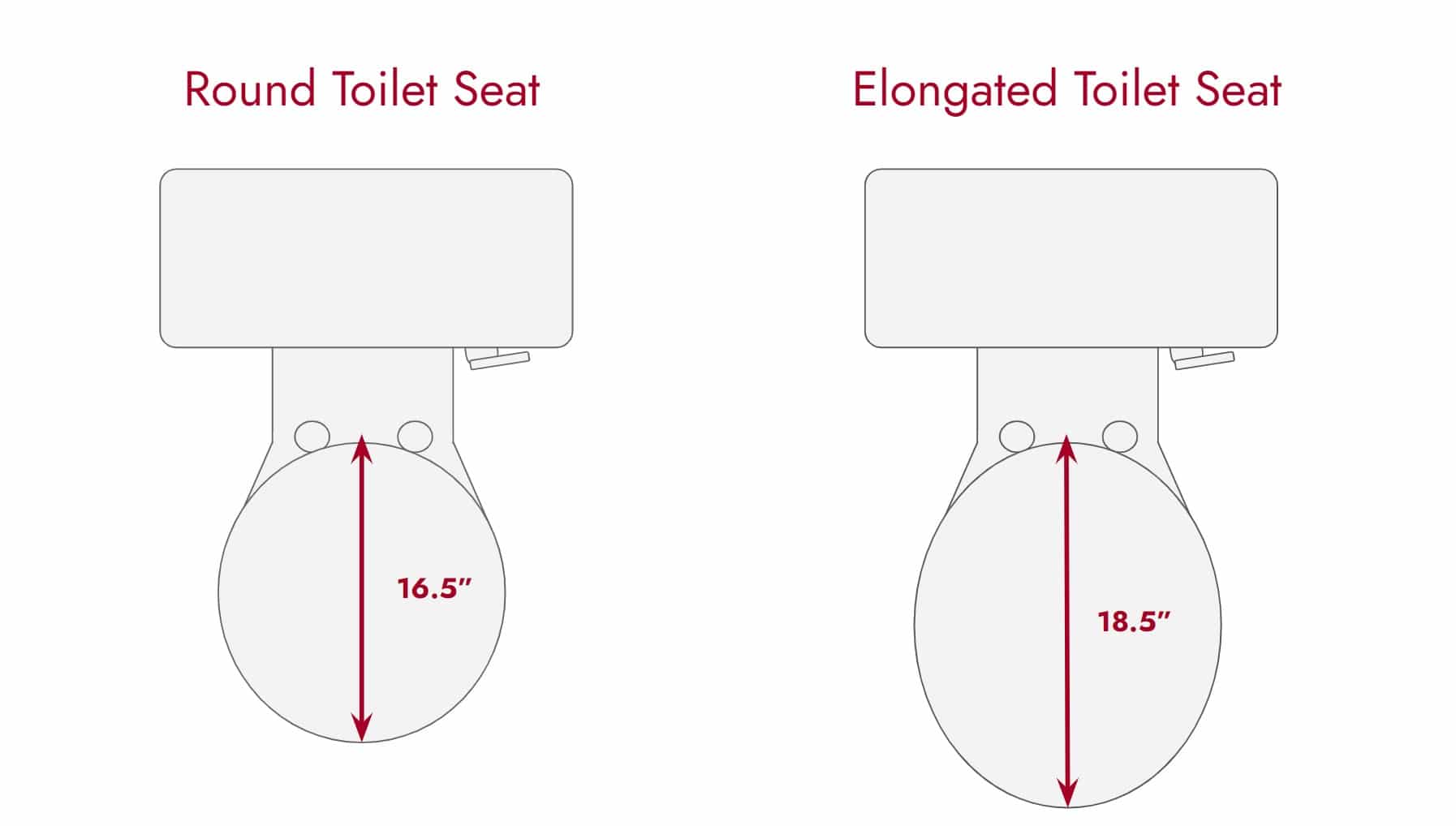
There are two categories of seat shapes (also known as bowl shapes): the round seat and the elongated seat, and each seat type generally has different length measurements. There are pros and cons to each selection. But it is important to note that for an ADA compliant stall, it is required to have an elongated seat.
- Round Toilet Seat Measurements
The round toilet seat or bowl is generally around 16.5 inches in length from the seat bolt holes (where you would attach your toilet seat) to the tip of the bowl. This bowl is shorter than the elongated toilet bowl, saving more space. It is also easier for children to use.
- Elongated Toilet Seat Measurements
The elongated toilet seat or bowl is approximately 18.5 inches in length from the seat bolt holes to the tip of the bowl. This style is considered more attractive and comfortable due to its shape. Again, this is the style required by the ADA for compliant stalls as it is easier to use for people with disabilities.
How to Measure Toilet Height
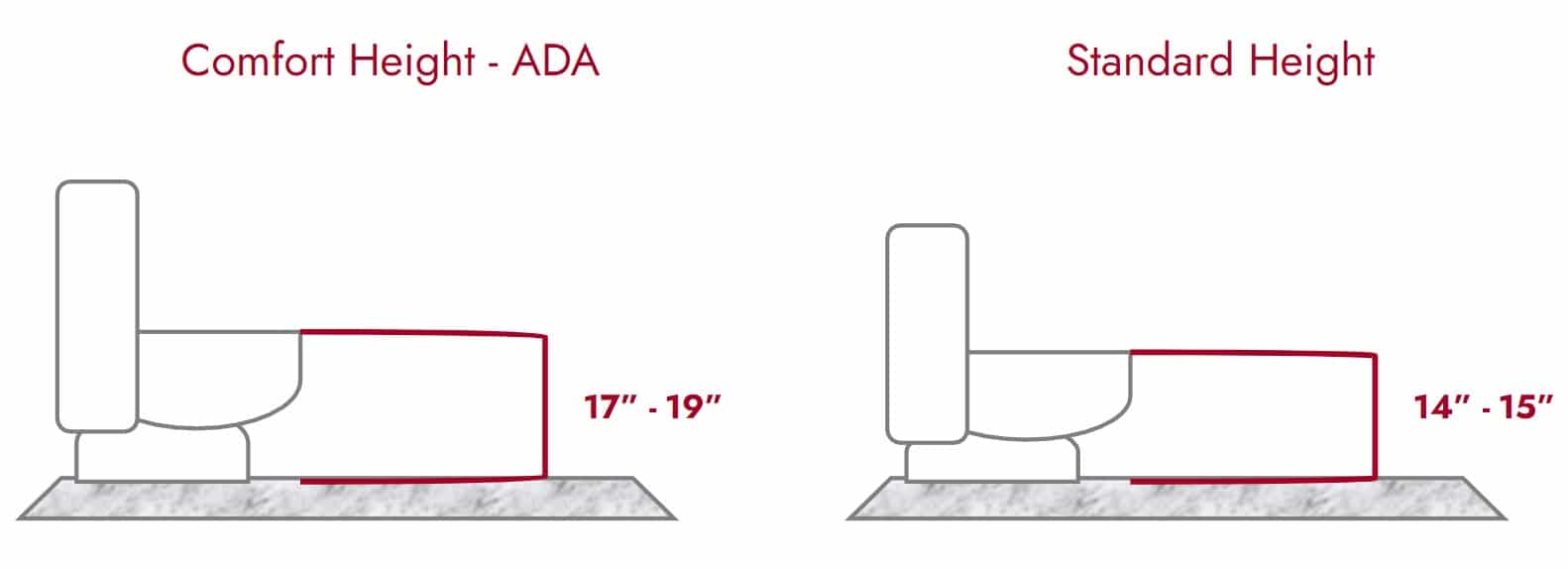
Toilets come in a variety of dimensions. While the width is pretty similar between types and brands, there are generally two standard seat heights of toilets. Each height variety has pros and cons. However, to be ADA compliant the seat height must be between 17 inches and 19 inches.
- Comfort Height Toilet Measurements
A comfort height toilet has the top of its seat 17 inches to 19 inches above the floor. This type of toilet is also known as a universal height toilet or an ADA-compliant toilet. These toilets are great for people with mobility issues, the elderly, and most adults. However, they can be on the heavy side, and children and short adults may find them to be tall.
- Standard Height Toilet Measurements
A standard height toilet has the top of its seat 14 inches to 15 inches above the ground. This type of toilet is great for kids and shorter adults. But other adults may have trouble using it, especially if they have mobility issues. You cannot use this toilet height for ADA-compliant stalls.
How Wide is a Toilet?
A standard toilet is approximately 20 inches wide. However, you will want to measure your choice of a toilet at its widest point. This point may be the bowl or the tank. This measurement is crucial to note, as ADA requirements demand a certain amount of space on either side of a toilet in ADA compliant stalls. After all, nobody wants to feel claustrophobic when sitting on a toilet.
How to Measure a Toilet Rough In
What is a Toilet Rough In?
The rough-in of a toilet is the space between the wall behind the toilet and the center of the drainpipe. You can also measure this space from the wall to the bolts that hold the toilet to the ground. Check out the photo below for a look at where you should be measuring.
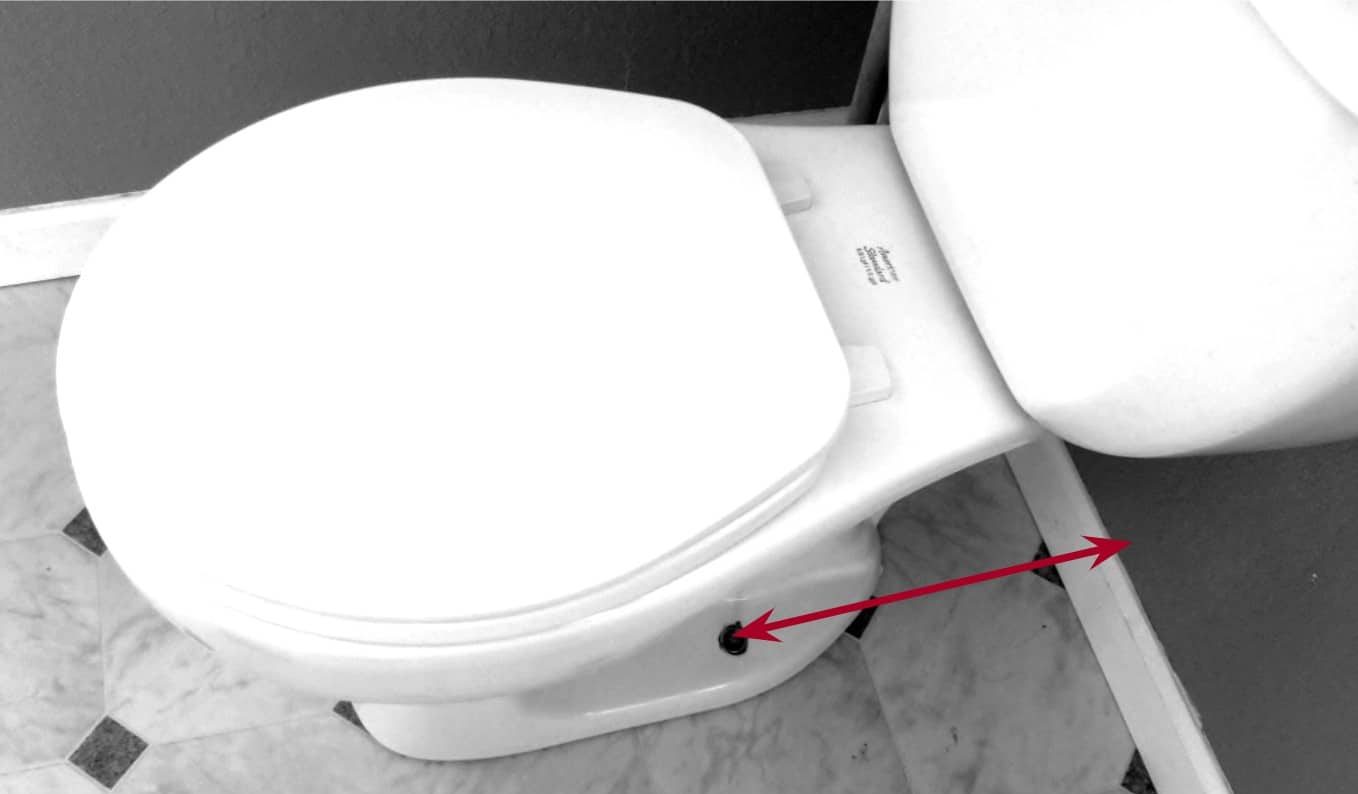
Toilet Rough In Dimensions
A standard toilet rough-in is 12 inches. However, a toilet rough in measurement can also be 10-inches or a 14-inches. When purchasing a toilet you need to ensure that the rough-in measurement matches what you have in your bathroom. If you choose a toilet with a larger rough in than your measurement, it will not fit. While a toilet with a smaller rough-in will fit in the space, it will leave a large gap between the wall and the toilet. This space can result in things placed on top of the toilet falling into the gap.
Step 4: Pick and Measure Your Sinks
Sinks are required in every bathroom in your establishment and should include alongside them soap and a way to dry your hands. There are many different options when it comes to sinks. Some people prefer sinks built into a long counter, while others prefer stand-alone sinks. It is a good idea to consider the width of the space you have set aside for your sinks, how many you will need, and how much space you want between them when choosing a type of sink.
Height can also vary when it comes to sinks. Different sinks can have depths that vary widely. However, depth and height off the ground can be crucial for ADA compliance. According to ADA regulations, a compliant sink must have a rim a maximum of 34 inches off the ground. If you design your bathroom to have the sinks approachable from the front, you must also leave sufficient floor space for wheelchair users. They should be able to fit their legs and feet under the sink. We have laid out the specific rules for floor space, sink height, and more in our Ultimate Guide to an ADA-compliant bathroom.
Step 5: Measure for Partitions
When building a restroom, you need space for more than just fixtures. It is a requirement that every toilet is separately enclosed. This enclosure usually happens with partitions that come in many materials and sizes. ADA compliant stalls and regular stalls each have different measurement requirements. Working with Partition Experts like the ones at Partition Plus can make understanding all the rules and requirements easy, plus you will get a great price on the partitions you want. But here, we will give a rudimentary look at spacing and measurements.
ADA Compliant – Wheelchair Accessible Stalls
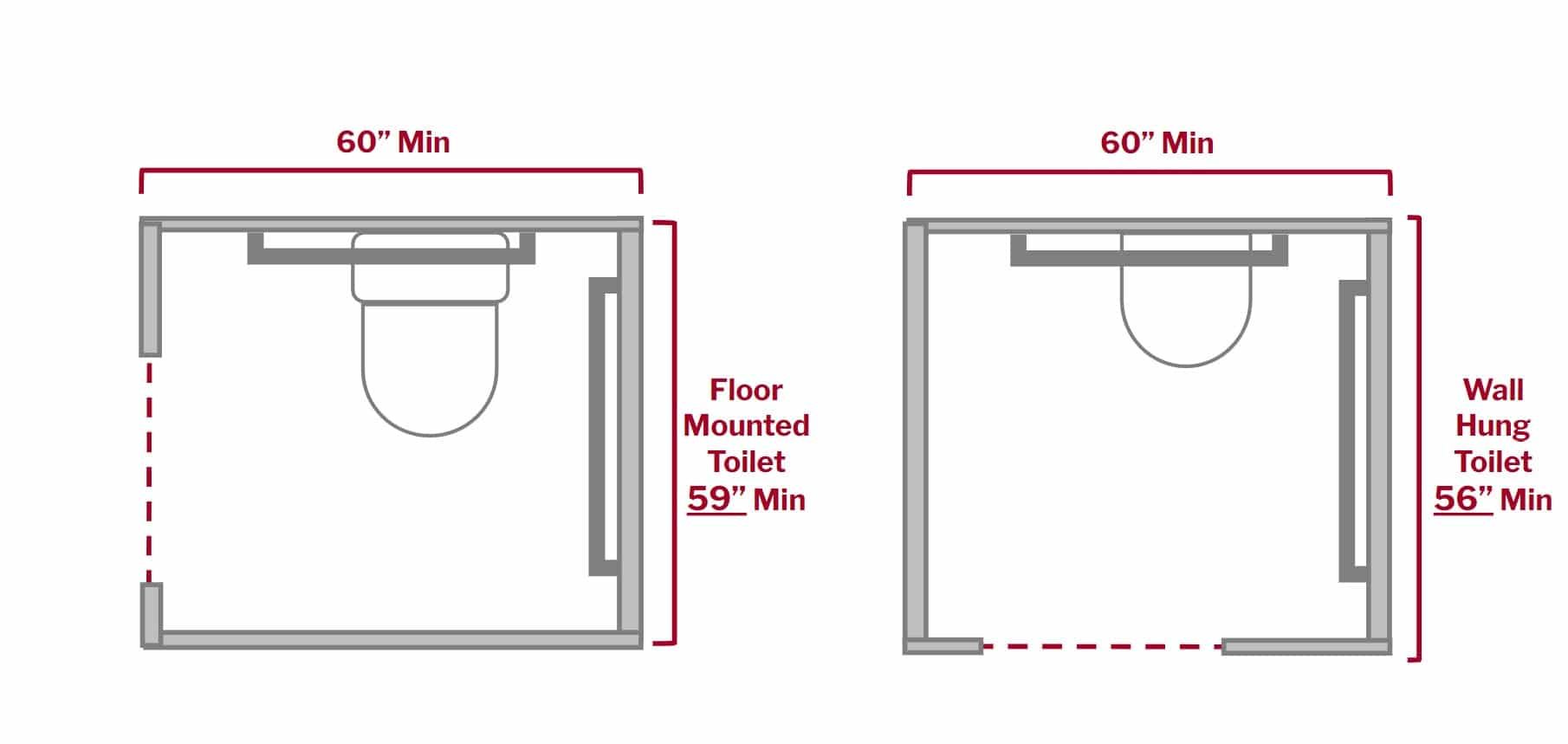
ADA compliant stalls for wheelchair accessibility are much larger than a standard stall. They must be at least 60 inches wide and a minimum of 56 inches deep if you have a wall-mounted toilet and 59 inches deep if you have a floor-mounted toilet. This space may need to be larger if you are including certain accessories like baby changing stations. Doors in wheelchair-accessible stalls usually swing outward. But if you want an inward swinging door you will need to include more space. Keep in mind wheelchair accessible stalls should not be made with only wheelchairs in mind. There should also be enough space for an assistant if necessary.
ADA Compliant – Ambulatory Accessible Stalls
ADA compliant stalls are made for those with disabilities who are ambulatory but still need assistance in the form of grab bars or other means. These stalls should be a minimum of 60 inches deep but must be between 35 inches and 37 inches wide. This spacing allows people to use the grab bars on either side of these stalls.
Standard Stalls
Standard stalls can be of a wide variety of sizes. You want to make sure that there is enough space for people to be comfortable inside the stalls. But you also need to ensure that you can fit as many toilets and stalls as you need in your bathroom. The most common size for a standard stall is 60 inches deep and 36 inches wide, similar to an ambulatory ADA compliant stall. But these dimensions can be customized when working with a partition supplier.
Conclusion
There are many aspects to consider when creating a brand new bathroom. But measuring does not have to be complicated. With these steps in hand, you will be able to pick stalls and fixtures that look great and fit perfectly.
If you feel you need a little more help with measuring or are looking to purchase great stalls and accessories, you are in the right place. The Partition Plus team is always happy to help people begin the process of designing their bathrooms. We have decades of experience offering bathroom partitions and accessories in a variety of sizes, colors, and price points.
If you are ready to take the first step in building your bathroom, contact us today at 800-298-9696 or sales@partitionplus.com.

